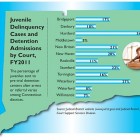Environmental Health
Number Of Lead-Poisoned Children Drops, But More Showed Higher Levels
|
Nearly 1,400 new cases of lead-poisoned children under age 6 were reported in Connecticut in 2015, a slight drop from the year before, but more children showed higher levels of poisoning. A child whose blood test shows 5 micrograms of lead per deciliter or higher is considered poisoned. The 2015 numbers show 98 new cases of children with lead levels of 20 micrograms or higher, four times the threshold number and a 32 percent jump from 2014. “We cannot, with any certainty, explain why this is the case,” said Krista M. Veneziano, coordinator of the Connecticut Department of Public Health’s (DPH’s) Lead, Radon, and Healthy Homes Program, about the disproportionately larger numbers of higher toxicity. Exposure to lead can damage cognitive ability, including a measurable and irreversible loss in IQ points.


